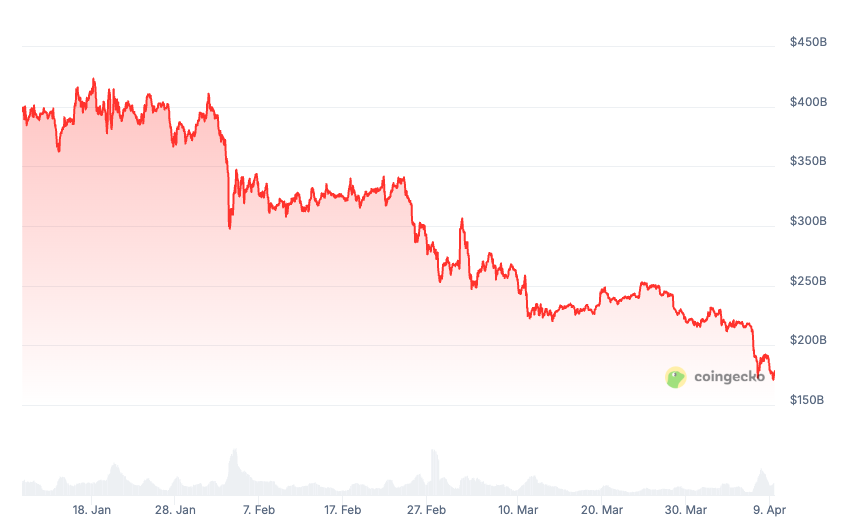Ethereum (ETH), the world’s second-largest cryptocurrency, is currently going through one of its most challenging periods since the 2022 bear cycle. After reaching a local peak of nearly 3,900 USD earlier this year, ETH has declined by more than 60% and is now trading around 1,400–1,600 USD.
This decline is sharper than Bitcoin and other major altcoins like Solana and BNB, which lost 30–40% of their value in the same time.
Macroeconomic and Fundamental Factors Affecting ETH Price
Macroeconomic Factors
In the short term, overall sentiment in the broader financial markets (stocks, forex, commodities) has a significant impact on the crypto market. Ethereum is often categorized as a risk asset, so when investors adopt a “risk-off” stance, ETH tends to decline.
Over the past 24 hours, ETH has dropped approximately 8%, trading around 1,600 USD. This decline comes as the entire crypto market faces pressure from macroeconomic headwinds and a broader risk-off sentiment among investors.

According to analysis from Citi Research, U.S. stock market volatility remains the most influential macro factor for digital assets like Bitcoin and Ethereum, while the impact of the U.S. dollar’s strength has been fading.
Other macro variables, such as global trade dynamics and geopolitical tensions, also indirectly influence Ethereum. For example, ongoing U.S.-China trade tensions or retaliatory tariff policies could hinder global economic growth, drag down equities, and make investors more cautious with crypto assets.
Additionally, as expectations grow for a spot ETH ETF, many institutions have started accumulating ETH as a yield-generating asset through staking.
However, this capital inflow is largely passive, contributing little to transaction volume or practical network usage. This creates a dynamic of “growing ownership but declining interaction,” making ETH appear less agile compared to smaller, more active assets like SOL or emerging meme coins, especially in the eyes of speculative traders.
Fundamental Factors
The Merge in September 2022 marked a major turning point as Ethereum transitioned to a Proof-of-Stake (PoS) consensus mechanism. This shift reduced new ETH issuance by 90% and cut energy consumption by up to 99%. It laid the foundation for Ethereum’s long-term “deflationary” narrative, positioning ETH as an increasingly scarce asset.
However, following the Dencun upgrade (EIP-4844), which significantly lowered gas fees on the Ethereum network,. The amount of ETH burned daily has dropped substantially. As a result, the deflationary narrative, once a key factor supporting ETH’s price, has lost some of its short-term appeal. In fact, ETH has returned to a “mildly inflationary” state. According to data from Ultrasound.money, ETH’s net issuance rate during the early weeks of 2025 has risen to approximately +0.28% per year, compared to negative issuance in 2023.
In addition, since Ethereum enabled staking withdrawals (Shapella upgrade), the amount of staked ETH has steadily increased, recently surpassing 40 million ETH – more than 33% of the total supply. However, this growth also brings the risk of periodic technical sell pressure.
According to Nansen, during weak market phases, many validators opt to unstake ETH and lock in profits, particularly those who staked when ETH was trading between 1,000 USD and 1,500 USD.
ETH Price Prediction
Short-Term Outlook
In the short term (over the coming weeks to a month), macroeconomic factors and overall market sentiment will likely continue to drive ETH’s price. If there are clear signals that the Federal Reserve is about to pivot toward rate cuts, or if weakening economic data forces the Fed to ease its policy stance, these factors could drive ETH’s price higher. The crypto market could see a “relief rally,” with improving liquidity pushing ETH prices higher.
Aside from the FED, the performance of the U.S. stock market and other risk assets remains a key indicator for ETH in the near term. If major indices like the S&P 500 and Nasdaq correct sharply, ETH is also likely to face widespread selling pressure.
Currently, ETH has dropped into its long-term support zone between 1,400 USD and 1,500 USD. If financial markets continue to weaken (with further declines in Nasdaq and S&P 500), ETH could retest the 1,200 USD level – a price not seen since June 2023.
Conversely, if the FED announces a clear rate-cut roadmap and an Ethereum spot ETF gains regulatory approval (even in principle), ETH could see a technical rebound toward the 1,800 USD – 2,000 USD range.
Overall, ETH price predictions in the short term remain highly uncertain and are extremely sensitive to real-time news and macro developments.
Mid-Term Outlook
In the mid-term, ETH’s price outlook will largely depend on the global macroeconomic environment and the potential recovery of institutional capital after a period of risk-off sentiment. Although Ethereum spot ETFs were approved by the SEC in mid-2024, market performance has been less positive than expected.
After a brief price surge following the approval, ETH quickly lost momentum and continued to decline alongside the broader market, suggesting that institutional inflows have yet to return in a meaningful and sustainable way.
In this context, macroeconomic conditions will be a key factor. If the Federal Reserve follows through with rate cuts by the end of 2025 and geopolitical risks do not escalate, ETH could benefit from a more favorable liquidity environment.
On the other hand, if the global economy enters a recession or investors begin to lose confidence in Ethereum’s competitiveness compared to alternative platforms like Solana, ETH may continue to trade below the 1,500 USD level for several months.
Additionally, some analysts believe ETH could range between 2,200 USD and 3,200 USD, with a possible return to the 3,500 USD – 5,000 USD range if institutional capital reenters, on-chain activity recovers, and Ethereum’s upcoming upgrades roll out smoothly.
Conclusion
Ethereum is currently undergoing a deep correction with no clear short-term recovery momentum. Despite the launch of spot ETFs, ETH has continued to decline due to macroeconomic headwinds, prevailing risk-off sentiment, and the fading appeal of narratives such as deflationary supply and Ethereum’s leadership in DeFi.
However, the technological foundation of Ethereum remains solid, supported by the growth of Layer 2 solutions and a clear roadmap of upcoming upgrades. In the medium term, if macro conditions stabilize and institutional capital returns, ETH could recover to the 2,200 USD – 3,500 USD range.
At present, ETH is no longer a choice for investors seeking quick gains, it has become a test of patience and long-term conviction.
Read the full article here





